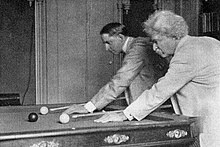
Samuel Langhorne Clemens, known by the pen name Mark Twain, was an American writer, humorist, and essayist. He was praised as the "greatest humorist the United States has produced," with William Faulkner calling him "the father of American literature." Twain's novels include The Adventures of Tom Sawyer (1876) and its sequel, Adventures of Huckleberry Finn (1884), with the latter often called the "Great American Novel." He also wrote A Connecticut Yankee in King Arthur's Court (1889) and Pudd'nhead Wilson (1894) and cowrote The Gilded Age: A Tale of Today (1873) with Charles Dudley Warner. The novelist Ernest Hemingway claimed that "All modern American literature comes from one book by Mark Twain called Huckleberry Finn."

The Miracle Worker refers to a broadcast, a play and various other adaptations of Helen Keller's 1903 autobiography The Story of My Life. The first of these works was a 1957 Playhouse 90 broadcast written by William Gibson and starring Teresa Wright as Anne Sullivan and Patricia McCormack as Keller. Gibson adapted his teleplay for a 1959 Broadway production with Patty Duke as Keller and Anne Bancroft as Sullivan. The 1962 film also starred Bancroft and Duke. Subsequent television films were released in 1979 and in 2000.

Louis-Honoré Fréchette was a Canadian poet, politician, playwright and short story writer. For his prose, he would be the first Quebecois to receive the Prix Montyon from the Académie française, as well as the first Canadian to receive any honor of this kind from a European nation.
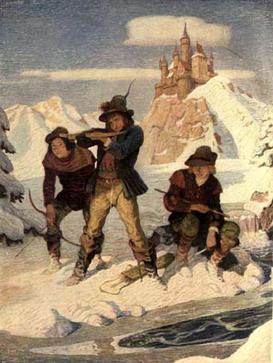
The Mysterious Stranger is a novella by the American author Mark Twain. He worked on it intermittently from 1897 through 1908. Twain wrote multiple versions of the story; each involves a supernatural character called "Satan" or "No. 44", encountering Huckleberry Finn and Tom Sawyer.
"The War Prayer", a short story or prose poem by Mark Twain, is a scathing indictment of war, and particularly of blind patriotic and religious fervor as motivations for war. The structure of the work is simple: an unnamed country goes to war, and patriotic citizens attend a church service for soldiers who have been called up. The people call upon God to grant them victory and protect their troops. Suddenly, an "aged stranger" appears and announces that he is God's messenger. He explains to them that he is there to speak aloud the second part of their prayer for victory, the part which they have implicitly wished for but have not spoken aloud themselves: the prayer for the suffering and destruction of their enemies. What follows is a grisly depiction of hardships inflicted on war-torn nations by their conquerors. The story ends with the man being condemned as a lunatic, "for there was no sense in what he said".

The Gilded Age: A Tale of Today is a novel by Mark Twain and Charles Dudley Warner first published in 1873. It satirizes greed and political corruption in post-Civil War America. Although not one of Twain's best-known works, it has appeared in more than 100 editions since its original publication. Twain and Warner originally had planned to issue the novel with illustrations by Thomas Nast. The book is remarkable for two reasons—it is the only novel Twain wrote with a collaborator, and its title very quickly became synonymous with graft, materialism, and corruption in public life. The novel gave the era its nickname: the period of U.S. history from the 1870s to about 1900 is now referred to as the Gilded Age.

The Autobiography of Mark Twain is a written collection of reminiscences, the majority of which were dictated during the last few years of the life of American author Mark Twain (1835–1910) and left in typescript and manuscript at his death. The Autobiography comprises a collection of anecdotes and ruminations rather than a conventional autobiography. Twain never compiled the writings and dictations into a publishable form in his lifetime. Despite indications from Twain that he did not want his autobiography to be published for a century, he serialized selected chapters during his lifetime; in addition, various compilations were published during the 20th century. However, it was not until 2010 that the first volume of a comprehensive three-volume collection, compiled and edited by The Mark Twain Project of the Bancroft Library at University of California, Berkeley, was published.
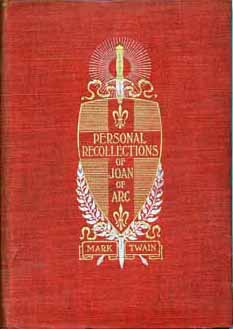
Personal Recollections of Joan of Arc, by the Sieur Louis de Conte is an 1896 novel by Mark Twain which recounts the life of Joan of Arc.

The Tent Dwellers is a book by Albert Bigelow Paine, chronicling his travels through inland Nova Scotia on a trout fishing trip with Dr. Edward "Eddie" Breck, and with guides Charles "the Strong" and Del "the Stout", one June in the early 1900s. Originally published in 1908, The story starts at what is now known as the Legendary Milford House; Renowned author Albert Bigelow Paine,, chronicled his first impression of the Milford House Lodge in his famous book, in the following way … "Then at last came a church, a scattering string of houses, a neat white hotel and the edge of the wilderness had been reached." Those travelling today from Annapolis Royal will witness little change in the scenery or the impact from this turn of the century description. The book takes place in what is now Kejimkujik National Park and the adjacent Tobeatic Game Reserve. The Reserve later became the Tobeatic Wildlife Management Area, and in 1998 was included within the newly created Tobeatic Wilderness Area.
"To the Person Sitting in Darkness" is an essay by American author Mark Twain published in the North American Review in February 1901. It is a satire exposing imperialism as revealed in the Boxer Uprising and its aftermath, the Boer War, and the Philippine–American War, expressing Twain's anti-imperialist views. It makes reference to the contemporary figures Emilio Aguinaldo, William McKinley, Joseph Chamberlain, William Scott Ament and others, and fueled the Twain–Ament indemnities controversy.

"Eve's Diary" is a comic short story by Mark Twain. It was first published in the 1905 Christmas issue of the magazine Harper's Bazaar, in book format as one contribution to a volume entitled "Their Husband's Wives" and then in June 1906 as a standalone book by Harper and Brothers publishing house.

Olivia Susan Clemens was the second child and eldest daughter of Samuel Clemens, who wrote under the pen name Mark Twain, and his wife Olivia Langdon Clemens. She inspired some of her father's works, at 13 wrote her own biography of him, which he later published in his autobiography, and acted as a literary critic. Her father was heartbroken when she died of spinal meningitis at age 24.

The Hollow Tree Snowed-In Book is a children's book of short stories written by Albert Bigelow Paine and illustrated by J. M. Condé. It was published by Harper & Brothers in 1910. The book contains the continued tales of the 'Coon, the 'Possum, and the Old Black Crow, who live in the Hollow Tree in the Deep Woods.
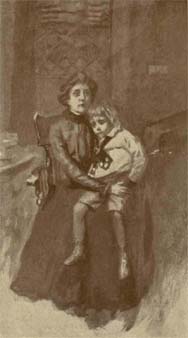
A Double Barreled Detective Story is a short story/novelette by Mark Twain, in which Sherlock Holmes finds himself in the American west.

The $30,000 Bequest and Other Stories (1906) is a collection of thirty comic short stories by the American writer Mark Twain. The stories contained span the course of his career, from "Advice to Young Girls" in 1865 to the titular tale in 1904. Although Twain had ample time to refine his short stories between their original publication date and this collection, there is little evidence to suggest he took an active interest in doing so. "A Burlesque Biography" contains only a few minor technical revisions which make it different from the 1871 version found in Mark Twain's "(Burlesque) Autobiography and First Romance". "Advice to Little Girls" shows slight revision from its earlier publication in The Celebrated Jumping Frog of Calaveras County.
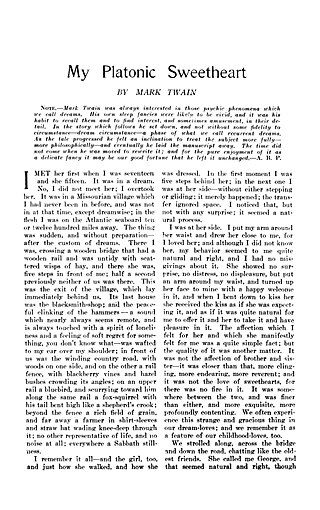
"My Platonic Sweetheart" is a short dream narrative written by American writer Mark Twain. It was originally titled "The Lost Sweetheart" and written during July and August 1898. It was published more than two years after Twain's death, in the December 1912 issue of Harper's Magazine. The main character has several dreams throughout his life about the same woman. The narrative depicts five of these dreams, and in each dream the main character and the woman take on different names. The woman's appearance also changes in each dream. However, the characters' ages in the dreams remain the same, he is seventeen and she is fifteen, and the two characters never fail to recognize each other.

Samuel Langhorne Clemens , well known by his pen name Mark Twain, was an American author and humorist. Twain is noted for his novels Adventures of Huckleberry Finn (1884), which has been called the "Great American Novel," and The Adventures of Tom Sawyer (1876). He also wrote poetry, short stories, essays, and non-fiction. His big break was "The Celebrated Jumping Frog of Calaveras County" (1867).

William Francis Ver Beck was an American illustrator known for his comedic drawings of animals.

The Paine House is a historic house in Xenia, Illinois, which was the home of author Albert Bigelow Paine. Built in 1858, the house was designed using elements of the Greek Revival and Gothic Revival styles. Paine lived in the house from 1873 to 1888; during this time, he began his writing career, authoring several stories and poems. Several of Paine's works were published in Xenia's local newspapers, which inspired him to pursue his career. Paine later became known for his close friendship with Mark Twain; Paine edited Twain's letters and wrote a multi-volume biography of the author. As of the 1980s, the house was still owned and occupied by the descendants of Paine's family.

Truman W. "True" Williams was an American artist known as the most prolific illustrator to Mark Twain's books and novels. He illustrated the first edition of The Adventures of Tom Sawyer (1876) and was thus the first to visually portray such characters as Tom Sawyer and Huckleberry Finn. He was also sole illustrator of Twain's Sketches, New and Old and primary illustrator of Roughing It and The Innocents Abroad. Working with a number of publishers he also illustrated works by writers Bill Nye, George W. Peck, Joaquin Miller, and others. He was also a notorious drunk, which slowed his work and made him unreliable.

